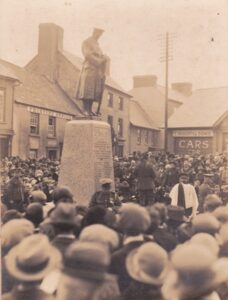Llandovery is an ancient market town situated in the Towy Valley, north of Llandeilo. The town centres around its ancient castle. Llandovery War Memorial is sited near to the castle in the centre of the town, and was unveiled by Brigadier Lewis Pugh Evans VC, CB, CMG, DSO and Bar, DL, who had married Margaret Dorothea Seagrave Vaughan-Pryse-Rice on 10 October 1918. Llandovery seems to have suffered a high proportion of casualties in the early stages of the Great War, with many of the men either being regular soldiers, or on the Army Reserve. There are several men of both wars missing from the memorial, and I have added them below. The names on the memorial match those on the two memorial plaques which are located within St. Dingat’s Church at Llandingat.
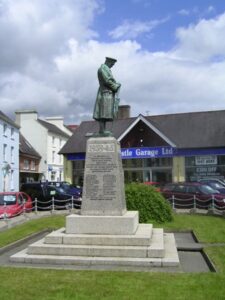
The Great War, 1914-1918
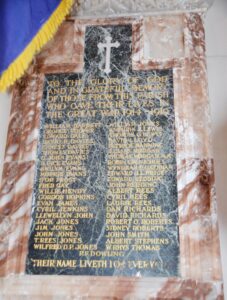
William Barratt, Private, 288052, Welsh Regiment. William was from Birmingham, and was residing at Llansadwrn when he married Catherine Kate Thompson, of Plasnewydd, Llansadwrn in 1914, and the couple moved to Victoria Street, Llandovery. William enlisted at Llandovery into the 4th Battalion, Welsh Regiment, and had fought in Gallipoli before becoming ill with enteric fever, and was invalided home. After recovering, he was posted to the 1/6th Battalion, Welsh Regiment, which had been in France since 29 October 1914. On 5 July 1915 the battalion transferred to 84 Brigade, 28th Division, and on 23 October 1915 transferred again, to 3 Brigade, 1st Division, becoming Divisional Pioneers on 15 May 1916. William was wounded during the Second Battle of Passchendaele and died of wounds at the Casualty Clearing Station at Dozinghem on 11 November 1917. He is buried in Dozinghem Military Cemetery, Belgium.
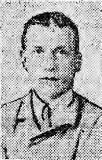
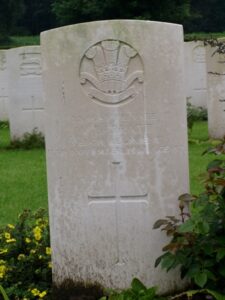
Arthur William Vincent Braddon, Private, 4734, Australian Imperial Force. Arthur was born in Llandovery, but had emigrated to South Africa. Arthur had married Edith Muriel Noble Pym in South Africa before the couple moved to Australia, setting up home at Eagles Nest, Panton Hill, Victoria. Whilst there, Arthur joined the Australian Militia, and had spent eight years prior to the war fighting at New Guinea. His service papers show that he had deserted his wife and children in 1913 and had enlisted at Sydney, New South Wales into the 9th Battalion, Australian Infantry as a single man. The contents of Arthur’s service papers are too comprehensive to put down here in detail but he was a bit of a colourful character that had been promoted and demoted for several incidents. Arthur’s battalion was attached to 3 Brigade, 1st Australian Division, and after a gruelling time on the Somme in 1916, moved to positions at Ypres. It was here, during the Battle of the Menin Road, that Arthur was killed in action, on 20 September 1917. He was 39 years old, and is remembered on the Ypres (Menin Gate) Memorial, Belgium. Arthur is not commemorated at Llandovery.
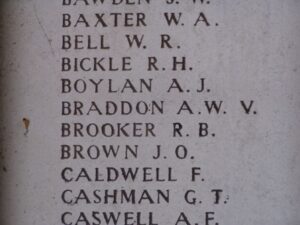
George Cooper, Private, 9133, Welsh Regiment. George was the son of Thomas and Elizabeth Cooper, of 28, Tarrington, Herefordshire. He had lived at Penlan, Telych, Llandovery prior to the war, and enlisted at Cardiff into the 2nd Battalion, Welsh Regiment, attached to 3 Brigade, 1st Division. The Division landed at Havre on 13 August 1914, and was one of the first British Units in France, where they fought in the Battle of Mons. After the retreat from Mons the Division retreated south to the Marne, where the German Offensive was held, and pushed them back to the Aisne. The Division was then moved north to guard the ancient City of Ypres, and were in the midst of the Battle of Langemark, when George was killed in action on 25 October 1914, aged 25. He is remembered on the Ypres (Menin Gate) Memorial, Belgium.
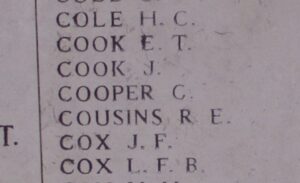
Edward Dale, Private, 13178, Devonshire Regiment. Edward was the son of Edward and Elizabeth Dale, of High Street, Llandovery. He had resided with Mr Will Jones, of 25, Railway Terrace, Alltwen prior to the war. Edward enlisted at Tonyrefail into the 10th Battalion, Devonshire Regiment, which was attached to 79 Brigade 26th Division. The Division landed at Boulogne on 23 September 1915 but were soon moved again, arriving in Salonika during November that year. Here they fought in the Salonika Campaign against the combined Bulgarian and Turkish forces, and it was here on 25 April 1917 that Edward was killed in action. He was 32 years old, and is remembered on the Doiran Memorial, Salonika. Edward is also commemorated at St. Peter’s Church, Pontardawe.
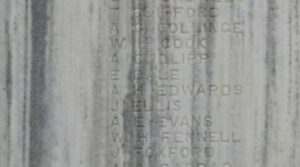
Caroline Jackson Davies, Chief Section Leader, G/3136, Women’s Royal Naval Service. Caroline was born on 22 December 1896, the daughter of John and Phoebe Davies, of King’s Road, Llandovery. Little is known of her, but she had lived with her sister Ruth at Old Road, Llanelli prior to the war. Caroline served with the Women’s Royal Naval Service, and died of sickness at Carmarthen on 26 October 1918, aged 22. She is buried at Llandingat (St. Dingat) Churchyard. Caroline doesn’t seem to be commemorated locally.
David Richard Davies, Private, 301861, London Regiment. David was the son of John and Margaret Davies, of 1, Victoria Crescent. Llandovery. He enlisted at London into the 1/5th Battalion (London Rifle Brigade), who had originally landed in France on 5 November 1914 as part of 11 Brigade 4th Division. On 25 October 1915 they joined 8 Brigade, 3rd Division, and on 10 February 1916 became part of 169 Brigade, 56th (London) Division. The Division fought at the diversionary attack on Gommecourt then at Ginchy, Flers and Morval, where they captured Combles. They wintered on the Somme, and followed the German retreat to the Hindenburg Line in March, 1917 before fighting in the Battle of Arras. They then moved to Ypres, where they fought at Langemarck, then at Cambrai during the Battle there in October 1917, remaining in the area for the winter. The Division were in the Arras sector when the German Spring Offensive was launched on 21 March 1918, and David was killed in Action during the Kaiserschlacht, at the First Battle of Arras, on 28 March 1918. He was 27 years old, and is remembered on the Arras Memorial, France.
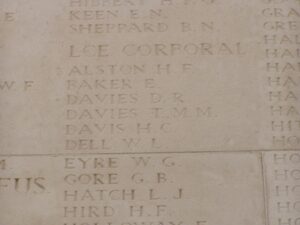
James Ernest Davies, Private, 5949, Royal Warwickshire Regiment. James was the son of John Isaac and Anne Davies, of 2, Castle Street, Llandovery, and enlisted at Carmarthen into the 4th Battalion, Welsh Regiment. Sometime later he transferred into the 2/7th Battalion, Royal Warwickshire Regiment, part of 182 Brigade 61st (2nd South Midland) Division, which had landed in France on 21 May 1916. The Division moved to the Flanders sector, near Fromelles, where they were to take place in a combined attack with the 4th Australian Division, as a diversion to the main attack on the Somme, but it was a slaughter, with thousands of lives lost needlessly, and James was killed in action on 10 July 1916, aged 25. He is remembered on the Loos Memorial, France. It took until December for his parents to receive official notification of his death. A mass grave has recently been exhumed at Fromelles, which contained over a hundred British and Australian graves. These men have been re-interred at Pheasant Wood Cemetery, Fromelles, and forensic study is underway to attempt to identify them.

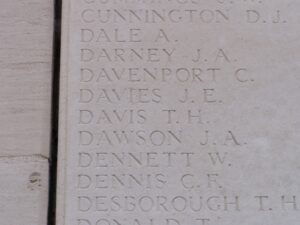
Thomas Davies, Private, 8852, South Wales Borderers. Thomas was the son of William and Rachel Davies, of Castle Street, Llandovery. He had seven years service in the 1st Battalion, South Wales Borderers prior to the war, having served in India. On 13 August 1914 the Battalion landed at Havre on 12 August as part of 3 Brigade, 1st Division, and moved to Mons, taking part in the Battle of Mons, and the epic retreat south. The division fought during the Battle of the Aisne, where the German drive on Paris was stopped, before the BEF was moved north to stave off the German drive towards the Channel coast. The BEF took up positions east of the ancient city of Ypres, with the 1st Division moving into the line at Langemarck on 21 October. The Germans launched a massive assault on the British that day, and were cut down in their hundreds by British rifle fire, in an action which later became known as the ‘Kindermord von Ypern’ (the massacre of the innocents at Ypres). After several days of heavy fighting, the 1st Division moved to positions in defence of Ypres along the Menin Road, near Zandvoorde. It was here that Thomas was killed in action on 27 October 1914, aged 39. He is remembered on the Ypres (Menin Gate) Memorial, Belgium. Thomas is not commemorated on the main war memorial at Llandovery, but in Llandingat Church.
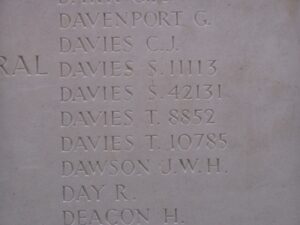
Digby Cecil Caleb Dickinson, Second Lieutenant, South Wales Borderers. Digby was born at Brecon on 10 October 1897, the son of Francis Digby Dickinson and Lucy Elizabeth Helen Dickinson (nee Jones), of Aberyskir Court, Brecon, and was the nephew of Alderman Douglas Thomas Maybery Jones, of Llandovery. He was educated at May Place, Malvern Wells, and Malvern College, where he won the Ledbury Run in 1916. Digby entered Sandhurst in August 1916 and was commissioned as Second Lieutenant into the South Wales Borderers in August 1917. He was then drafted to France and on 29 August joined the 2nd Battalion, South Wales Borderers, which was at Plumstead Camp, Ypres, attached to 87 Brigade, 29th Division. The battalion was rebuilding following heavy losses at Langemarck, before taking part in further fighting near Poelcapelle. Early in October 1917 the Division was relieved from the line at Ypres, and moved south to the Bellacourt area, to prepare to take part in the forthcoming Battle of Cambrai. The Division entrained for Péronne on 17 November, marching to a camp four miles out of the town at Haut Allaines, then by midnight on 18 November had reached Fins. On the following day the Division received its battle stores and detailed orders for the forthcoming battle, marching off via Gouzeaucourt to its assembly positions at Marcoing. The assault began at dawn on 20 November, but the Division suffered terrible casualties whilst attacking Masnières, on the Hindenburg Line. The Division wintered on the Hindenburg Line before returning to Ypres in January 1918, taking over positions near the Goudberg Spur. To the south, the Germans launched the first phase of their Spring offensive on the Somme on 21 March, then on 9 April switched their attention to the Lys, so the 29th Division was relieved from its positions on Passchendaele Ridge and thrown into action during a desperate defensive action near Les Haies Basses and saw heavy casualties over the coming days. Digby was slightly wounded during the fighting in April 1918, but soon returned to duty. The Germans switched their attention to the Chemins-des-Dames in May, so the 29th Division, now holding the line at Vieux Berquin, had a relatively quiet few months. To the south, following a great Australian and Canadian victory at Villers-Bretonneux on 8 August, the Allies began preparing to launch a great offensive along the Somme front. Meanwhile, the 2nd SWB, now in the Merris Sector moved into the front line near Outtersteene on 15 August to begin a routine tour in the line. On 18 August 1918, 87 Brigade launched an assault against the German lines in order to regain some lost ground. Digby was killed in action during the assault that day. The 20-year-old is buried in Borre British Cemetery, France. His brother Francis was killed just a month later. Neither brother is commemorated at Llandovery.

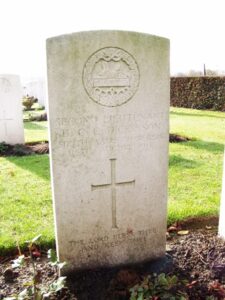
Francis John Twysden Dickinson, Captain, South Wales Borderers. Francis was born at Llandovery on 8 November 1896, the son of Francis Digby Dickinson and Lucy Elizabeth Helen Dickinson (nee Jones), of Aberyskir Court, Brecon, and was the nephew of Alderman Douglas Thomas Maybery Jones, of Llandovery. He was educated at May Place, Malvern Wells, and Wellington College, before entering Sandhurst in January 1915. In the following June he was commissioned as Second Lieutenant into the South Wales Borderers and was drafted to Egypt in January 1916, joining the 2nd Battalion, South Wales Borderers, which was attached to 87 Brigade, 29th Division and had just been evacuated from Gallipoli. The Division then transferred to the Western Front, landing at Marseilles on 15 March and entraining for the Somme sector, taking up positions near Beaumont Hamel, facing Y-Ravine. Francis was wounded here soon afterwards, when the Germans raided the battalions trenches on 7 April 1916. He was slowly evacuated home through the chain of Field Ambulances, Casualty Clearing Stations and Base Hospitals and spent six months recuperating. He then spent several months on home service before embarking for Salonika in June 1917, and was posted to the 7th Battalion, South Wales Borderers, which was attached to 67 Brigade, 22nd Division. Francis was killed in action in Salonika on 17 September 1918, aged just 21, and is buried in Doiran Military Cemetery, Salonika. His brother, Digby, had been killed in France the previous month. Neither brother is commemorated at Llandovery.

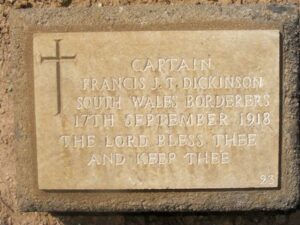
Patrick Francis Dowling, Private, 34197, Royal Welsh Fusiliers. Patrick was born in Kilkenny, and was the husband of Esther Mary Dowling, of 25, Oak Street, Aberdare. He worked as a miner at Aberdare prior to the war, and enlisted there into the 9th Battalion, Welsh Regiment, on 23 April 1915. He was later posted to the 3rd Welsh, before being posted to the 1st (Garrison) Battalion, Royal Welsh Fusiliers, which was based at Gibraltar, from 11 August 1915. Patrick was posted to France on 22 July 1917, where he joined the 10th Battalion, Royal Welsh Fusiliers, which formed part of 76 Brigade, 3rd Division. The Division had been in France since 27 September 1915, and fought in the Ypres area, around St. Eloi and Hooge, before moving south to take part in the Somme Offensive of 1916. They fought at Arras in March, 1917, pushing the Germans back toward the Hindenburg Line, and then moved to Ypres for the Battle of Third Ypres. Patrick joined the battalion at Ypres on 25 August 1917. Sadly, Patrick was wounded weeks later, at the Battle of Polygon Wood. He died of wounds on 27 September 1917 and is buried in Dozinghem Military Cemetery, Belgium. By the time of his death, Esther was living at 16, King’s Arms Street, Llandovery, with their three children, William, Patrick and Hilda. According to Patrick’s service papers three of his brothers reportedly also fell in the war.
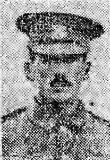
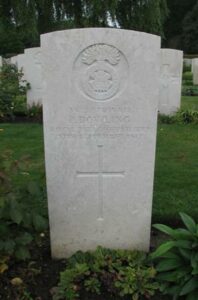
Daniel Morgan Evans, Private, 14878, South Wales Borderers. Daniel was born in Llandovery, the son of William and Elizabeth Evans. The family later lived at 2, Salem Road, Felinfoel. Daniel was the Husband of Catherine Siddell (formerly Evans), who remarried after the war, and moved to 33, Greengate Street, Carnarvon. Daniel enlisted at Aberystwyth into the 1st Battalion, South Wales Borderers. On 13 August 1914 the Battalion landed at Havre as part of 3 Brigade, 1st Division, and moved to Mons, where they fought in the Battle of Mons. They then took part in the epic retreat south, fighting until the Germans had been stopped at the Marne and then brought north to help in the defence of Ypres. At Ypres, the Division fought at the Battles of First Ypres, and moved south to Givenchy, where Daniel was killed in Action, aged 31, on 21 December 1914. He is remembered on the Le Touret Memorial, Richebourg L’Avoue, France. Daniel is not commemorated at Llandovery.
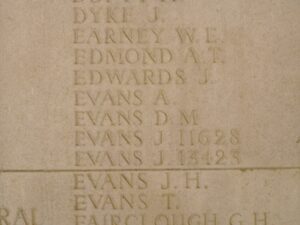
David John Evans, Bombardier, 43190, Royal Garrison Artillery. David was born in Llandovery in 1887. For several years prior to the war he had lived with his brother, William Evans, at 23, Twyn-y-Yfald Road, Pengam, Mon. He enlisted at Caerphilly into the Royal Garrison Artillery, serving in their 144th Siege Battery. David was killed in action during the advance on the Hindenburg Line, on 9 September 1918, aged 30. He is buried at Lebucquière Communal Cemetery Extension, France.
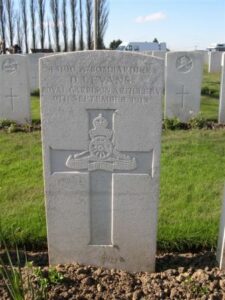
David Rice Evans, Private, R/9439, Kings Royal Rifle Corps. David was the son of Rees and Mary Evans, of 45, Stone Street, Llandovery, and enlisted there into the 2nd Battalion, Kings Royal Rifle Corps. At the outbreak of war the Battalion was at Blackdown, attached to 2 Brigade, 1st Division, and the Division moved immediately, landing at Havre on 13 August 1914, taking up positions around Mons. They fought on the Marne and the Aisne, before moving to Ypres, where they fought at First Ypres, and then at Aubers in early 1915. They took part in the Battle of Loos in September that year, and in 1916 fought on the Somme, from the Battle of Albert in July onwards, and were on the Ancre over the winter of 1916/17 when David was wounded. He was evacuated to the Base Hospital at Le Havre, where he died of wounds on 10 January 1917, aged 32. He is buried in Ste. Marie Cemetery, Le Havre, France. His parents had only just received the news that his brother, Gwilym Daniel Evans, has also been killed.

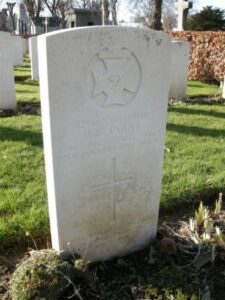
Edward Delmé Evans, Private 55318, Welsh Regiment. Edward was born at Llandovery in 1897, the son of Edward and Jane Evans. The family was living at 14, Signal Terrace, Oswestry by 1901, and Edward’s father was working in the town as a clogger. By 1911 the family had moved to 8, Ash Road, Oswestry and young Edward worked for the Great Western Railway at Oswestry. He enlisted at Oswestry into the King’s Shropshire Light Infantry and after completing his training was drafted to France in the summer of 1917, joining the 2nd Battalion, Welsh Regiment, which was attached to 3 Brigade, 1st Division. The Division had followed the German withdrawal to the Hindenburg Line in March 1917, then the 2nd Welsh spent several weeks undergoing training and rebuilding at Chuignes and Rouy-les-Grand before moving to Roisel by 27 April and Fletre by the beginning of June. Edward probably joined the 2nd Welsh at Fletre on 8 June, just before the battalion moved to Dickebusch Lake, in the Ypres Salient with the 1st Division. The battalion then began supplying working parties in the St. Eloi sector, before the Division moved to Caestre on 16 June, preparatory to the entire Division being transferred to Le Clipon Camp, near Coxyde on the Flanders coast, to prepare for a possible offensive. The operation was cancelled when it became clear that the Passchendaele offensive had bogged down, so on 7 November 1917 the Division entrained for the Ypres Salient, taking over a section of the front line on Passchendaele Ridge the following day. On 10 November the 2nd Welsh took part in an assault against the ridge, but was forced to withdraw to Irish Farm. The battalion was relieved on the following day and marched back to Dambre Camp to rest, then on 15 November moved back into the front line near the Paddebeek. Edward was killed in action here by enemy shellfire on 17 November 1917. The 20-year-old has no known grave and is commemorated on the Tyne Cot Memorial, Belgium. The family later resided at Tanyard Row, Llansantffraid. Edward is not commemorated at Llandovery.
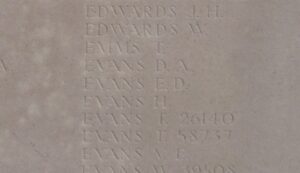
Gwilym Daniel Evans, Private, 780, Welsh Guards. Gwilym was the son of Rees and Mary Evans, of 45, Stone Street, Llandovery, and enlisted at Ammanford into the newly formed 1st Battalion of the Welsh Guards, which were raised by Royal Warrant of 26 February 1915. On 18 August 1915 the Battalion landed at Havre, as part of 3 Guards Brigade, Guards Division, and were thrown immediately into action at the Battle of Loos. After Loos, the Division spent a period at rest in Calais, and then spent a short period at Ypres during June 1916 before moving to the Somme in September. On the Somme they fought at Flers-Courcelette, and at Morval, and they then spent the winter in the trenches around Bronfay Camp. Gwilym was killed in action here on 27 December 1916, and is buried in Bronfay Farm Military Cemetery, Bray-Sur-Somme, France. His brother, David Rice Evans, was killed just weeks later.

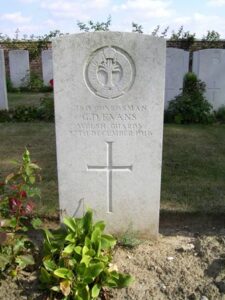
Morris Evans, Private, 8136, Welsh Regiment. Morris was the son of Titus and Mary Evans, of Cwmdwr, Llanwrda. He married Agnes Smyth in 1908 and the couple had five children, all born at Llandovery, before moving to 13, Mary Street, Seven Sisters. Morris was probably a pre-war regular, and re-enlisted at Ferndale into the 2nd Battalion, Welsh Regiment. The battalion was sent to France as part of 3 Brigade, 1st Division which were one of the first Divisions in France, landing at Havre on 13 August 1914. After the retreat from Mons to the Aisne, they were moved to Ypres, where Morris was killed in Action during the First Battle of Ypres, at Gheluvelt on 23 October 1914, aged 29. He is buried at Perth Cemetery (China Wall), Belgium. His twin brother, Evan, served with the 13th Welsh.

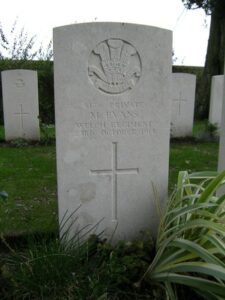
Ivor Frost, Private, 29634, Machine Gun Corps. Ivor was the son of William and Mary Frost, of 41, High Street, Llandovery. He enlisted at Llandovery into the Welsh Regiment. In 1916 the specialist Machine Gunners in each battalion were formed into Machine Gun Company’s and so Ivor moved to the 6th Company, Machine Gun Corps, which was attached to the 2nd Division. The Division were on the Somme, fighting during The Battle of Delville Wood, when Ivor was wounded. He was brought to the Casualty Clearing Station at Corbie, where he died of wounds on 12 August 1916, aged 22. Ivor is buried at La Neuville British Cemetery, Corbie, France.
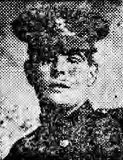
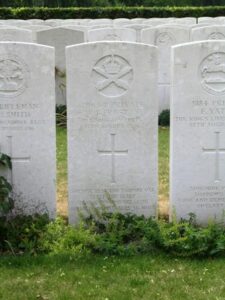
Thomas Edward Douglas Garrity, Private, 18950, Welsh Regiment. Thomas was the son of Bernard Garrity, of 13, Sutherland Street, Pimlico, London, and enlisted at Llandovery into the 2nd Battalion, the Welsh Regiment, attached to 3 Brigade, 1st Division. The Division was one of the first Divisions in France, and fought in the retreat from Mons to the Marne. They then moved to Ypres, where the 2nd Welsh took part in the famous stand at Gheluvelt, before spending the winter in the trenches. In March 1915 they took part in the Battle of Aubers, and this is where Thomas was killed in Action, on 29 March 1915, aged just 17. He is remembered on the Le Touret Memorial, Richebourg L’Avoue, France. Thomas is not commemorated at Llandovery.
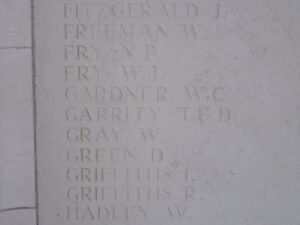
Frederick Gay, Private, 201017, Welsh Regiment. Frederick was from Holloway, Middlesex, and resided at Brynderw, Llandovery prior to the war. He initially served with the 4th Battalion, Welsh Regiment in Gallipoli, before being wounded and later posted to France, where he joined the 14th Battalion, Welsh Regiment, known as the Swansea battalion, which was attached to 114 Brigade 38th (Welsh) Division. The Division had landed in France during December 1915 and had spent their first winter in the trenches near Armentieres, and in July 1916 had famously captured Mametz Wood. The Division suffered terrible casualties at Mametz, and were taken out of the line, and moved to Ypres to rebuild. At Ypres on 31 July 1917 the Battle of Third Ypres was launched. Messines Ridge had been taken, and the focus now fell on the Pilckem Ridge. It was during the assault on the Pilckem Ridge that Frederick was killed in action, on 31 July 1917. He is buried in Cement House Cemetery, Belgium.
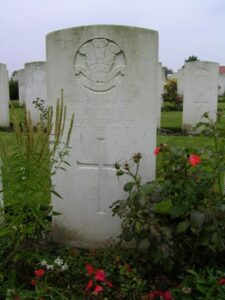
William John Hendy, R/9436, Kings Royal Rifle Corps. William was the son of Henry John and Lydia Hendy, of Ystrad Cottage, Llandovery. Henry was a gardener at Ystrad Hall, and William worked with him there, before enlisting at Llandovery into the 1st Battalion, Kings Royal Rifle Corps in February 1915. The battalion was attached to 99 Brigade, 2nd Division, and had been in France since landing at Rouen on 13 August 1914, and had fought in the retreat from Mons to the Marne. They moved to Ypres, where they fought in First Ypres, and then at Festubert in 1915, which is where William joined the battalion. He fought at La Bassée and at Loos later in the year, where he was shot in the thigh and gassed. William rejoined the battalion in May 1916. William was killed in action on the Somme, on 27 July 1916, aged 21. He is buried in Serre Road Cemetery No. 2, France.
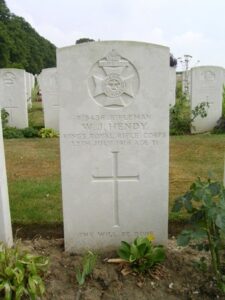
John Gordon Hopkins, Private, 8247, East Surrey Regiment. John was the son of David and Mary Anne Hopkins, of Llandovery. His father died in 1888, and David and his brothers and sisters all split up, residing at various locations around the country by 1891. John enlisted at London into the 1st Battalion, East Surrey Regiment, part of 14 Brigade, 5th Division. The Division saw their first action at Mons on 23 August 1914, and fought in the retreat South to the Aisne, then moved to La Bassée and then Messines, where they fought at First Ypres. John was killed in action at Messines on 22 October 1914, aged 37. He is remembered on the Le Touret Memorial, Richebourg L’Avoue, France.
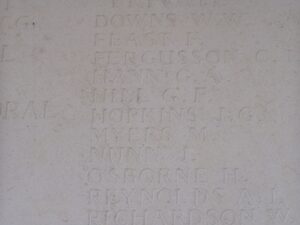
David Thomas James, Sergeant, 4804, South Wales Borderers. David was born in Llandovery, the son of Jabez Price James and Jane James (nee Prytherch). Jabez was a Tailor at High Street Llandovery, but moved the family to 17, Commercial Street, Cardiff when Jane died in 1904. David enlisted at Brecon into ‘E’ Company, 3rd Militia Battalion of the South Wales Borderers on 17 September 1894, and a month later joined the regular 1st Battalion, fighting with them during the Boer War of 1899-1901. David remained in the army after the Boer War, and at the outbreak of the Great War he was a reservist, and was recalled to the colours. David was posted to France in 1916, joining the 1st Battalion, South Wales Borderers, who were at Loos, attached to 3 Brigade 1st Division. He had not been long at the front when he was killed in Action on 19 May 1916. He was 38 years old and is buried at Maroc British Cemetery, Grenay, France. David is not commemorated at Llandovery.
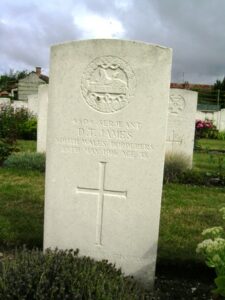
Evan James, Private, 11752, Welsh Regiment. Evan was the son of William and Elizabeth James, of Castle Square, Llandovery. He resided with James Maundrell at Ferry Road, Grange, Cardiff, and worked at the Penarth Cement Works prior to the war. Evan had served during the Boer War with the Welsh Regiment, and as a reservist was recalled to the colours at the outbreak of the Great War, joining the 2nd Battalion, Welsh Regiment, which moved to France attached to 3 Brigade, 1st Division. The Division fought at the retreat from Mons to the Marne, before moving to Ypres, where they fought at First Ypres, and then at Aubers in early 1915. They took part in the Battle of Loos in September 1915, and in 1916 fought on the Somme, where Evan was killed in action during the Battle of Bazentin Ridge, on 16 July 1916, aged 41. He is buried at Flatiron Copse Cemetery, Mametz, France.
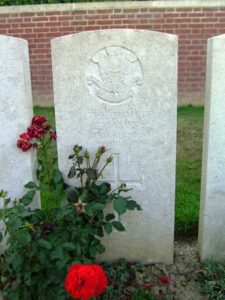
Joseph Cyril Wynne Jenkins, Private, 23353, Royal West Surrey Regiment. Joseph was the son of Reverend Joseph Jenkins and Mary Jenkins, of Pendennis, Llandovery. He had travelled around the country with his parents, after being born at Newquay. He had resided at Blaenau Ffestiniog, before enlisting at Tunbridge Wells, originally into the East Kent Regiment but later transferred into the 10th Battalion, Royal West Surrey Regiment, part of 124 Brigade, 41st Division. Cyril was wounded during the German Spring Offensive of 1918, and brought to Etaples to the Base Hospital, where he died of wounds on 9 April 1918, aged just 20. He is buried at Étaples Military Cemetery, France.

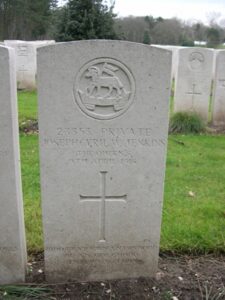
Llewellyn John, Lance Corporal, 5276, Royal Warwickshire Regiment. Llewellyn was the son of Isaac and Margaret John, of Little Whitehall, Robeston Wathen. He worked as a monumental mason at Llandovery prior to 1911, and had married Florence Mary Fox, a domestic servant, at Llandovery in 1912, and the couple had their daughter, Margaret, later that year. Llewellyn enlisted at Carmarthen into the 4th Battalion, Welsh Regiment, and was billeted at 18, St. Davids Street, Carmarthen whilst training. He was one of a number of men who were posted to the 2/7th Battalion, Royal Warwickshire Regiment, in 182 Brigade 61st Division. The Division arrived on the Western Front during May 1916 and moved to Fromelles, relieving the 38th (Welsh) Division. The 61st Division was intended to take part in a diversionary attack at Fromelles during July 1916, but Llewellyn was killed in action at Fromelles, prior to this disastrous assault, on 30 June 1916, aged 27. He is buried at Pont-Du-Hem Military Cemetery, La Gorgue, France. Florence later returned to her native Devon, and died in 1973, after having never remarried.
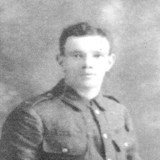
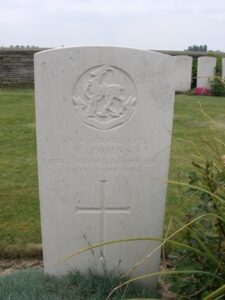
David John Jones, Corporal, 43393, Essex Regiment. David was born in Llandovery, the son of John and Mary Jones. The family moved to The Red House, Shuckburgh, Daventry, Northants at some time between 1901 and 1911. He enlisted at Leicester into the Leicester Regiment, but later transferred into the 9th Battalion, Essex Regiment, part of 35 Brigade, 12th (Eastern) Division. The Division landed at Boulogne on 31 May 1915, and took over the line at Ploegsteert Wood. They then moved south and fought in the Battle of Loos, and remained there until March 1916. By June 1916 they were in position at the Somme, and attacked Ovillers on 2 July 1916. They fought at Pozieres and Le Transloy before being moved to the Arras area, where they fought in the March 1917 Battle of Arras, and it was at a later stage of this at the Battle of Arleux, that David was killed in action on 29 April 1917, aged 28. He is remembered on the Arras Memorial, France. His brother Goronwy also fell. (See below), but neither are commemorated at Llandovery.
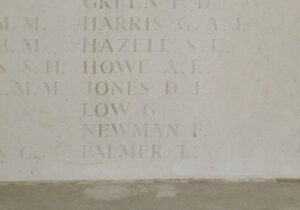
David Rees Jones, Private 14574, South Lancashire Regiment. David was born at Llandovery in 1881 the son of John Price Jones and Anne Jones. The family later resided at 13, Gresham Place, Treharris. He enlisted at Penrhiwceiber into the 8th Battalion South Lancashire Regiment, which was attached to 75 Brigade, 25th Division. The Division moved to France in September 1915, and were posted to the Vimy area, until they moved to the Somme in June 1916, where they attacked near Thiepval on 3 July 1916. They then attacked in the Battle of Bazentin Ridge, and this is where David was killed in Action on 15 July 1916, aged 35. He is remembered on the Thiepval Memorial, France. David is not commemorated at Llandovery.
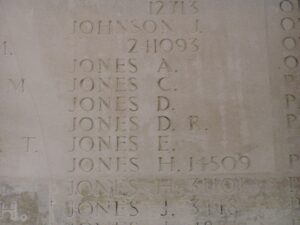
Goronwy Jones, Lance Corporal, 164708, Machine Gun Corps. Goronwy was born at Blaenos, Llandovery, the son of John and Mary Jones. The family later resided at The Red House, Shuckburgh, Daventry, Northants. He enlisted into the 100th Battalion, Machine Gun Corps, attached to the 33rd Division, and they had fought since the Somme Battles of 1916. They were at Third Ypres, and were in Flanders when the German Spring Offensive of March 1918 hit, and fought there until the tide of war had turned, and they moved south to take part in the great offensive against the Hindenburg Line. Goronwy was wounded during the Battle of the St. Quentin Canal, and Died of Wounds aged 22, on 1 November 1918. He is buried at Ste. Marie Cemetery, Le Havre, France. His brother David John Jones also fell (See above), but neither are commemorated at Llandovery.
James Jones, Private, 20026, Welsh Regiment. James was the son of Daniel and Mary Jane Jones, of 4, Towy Avenue, Llandovery. He enlisted at Ammanford along with his brother John, into the 15th Battalion, the Welsh Regiment, which was the Carmarthen Pals battalion, attached to 114 Brigade, 38th (Welsh) Division. The Division landed in France in December 1915 and moved to the Armentieres area where they were initiated into trench warfare. They then moved to the Somme in June, 1916, to take part in the attack on Mametz Wood, which began on 7 July 1916. The attack failed, and so 114 Brigade went in again on 10 July and were decimated. James was killed in action during the assault across ‘Death Valley’, on 10 July 1916, alongside his brother John. He was 21 years old and is remembered on the Thiepval Memorial, France.

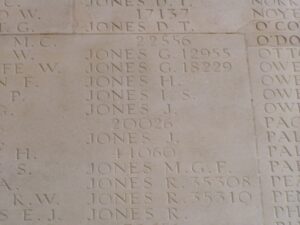
John Jones, Corporal, 20027, Welsh Regiment. John was the son of Daniel and Mary Jane Jones, of 4, Towy Avenue, Llandovery. He enlisted at Ammanford along with his brother James, into the 15th Battalion, the Welsh Regiment, known as the Carmarthen Pals battalion, which was attached to 114 Brigade, 38th (Welsh) Division. The Division landed in France in December, 1915 and moved to the Armentieres area where they were initiated into trench warfare. They then moved to the Somme in June, 1916, to take part in the attack on Mametz Wood, which began on 7 July 1916. The attack failed, and so 114 Brigade went in again on 10 July, and were decimated. John was killed in action during the assault across ‘Death Valley’, on the 10 July 1916, alongside his brother James. He was 24 years old and is remembered on the Thiepval Memorial, France.
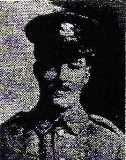
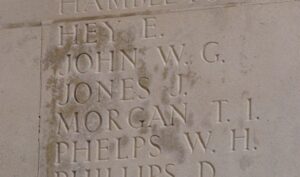
John C. Jones (Jack), Private, 235388, Royal Welsh Fusiliers. John was the son of Mrs. Elizabeth Jones, of 47, Stone Street, Llandovery, and enlisted at Llanelli into the Welsh Regiment. He later transferred into the 2nd Battalion, Royal Welsh Fusiliers who by March 1918 had been transferred into 115 Brigade, 38th (Welsh) Division. The Division were rushed to the Somme in spring 1918 to reinforce the hard pressed British Army there, after they had lost almost all of the ground taken over the previous 18 months, and helped turn the tide, and push the Germans back towards their own lines again. It was after the Germans had been driven back from Albert toward Bapaume that John was killed in action on 1 September 1918, aged 30 during the Second Battle of Bapaume. He is buried at Sailly-Saillisel British Cemetery, France.

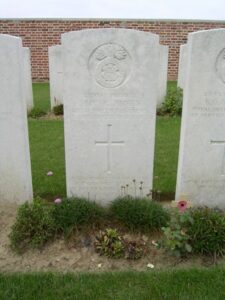
Thomas Jones, Private, 15640, Royal Welsh Fusiliers. Thomas was born in Llandovery, the son of Thomas and Margaret Jones. Prior to the war his father had died, and Margaret had remarried, moving the family to 8, Challis Row, Hirwaun, Glam. Thomas enlisted at Hirwaun into the 10th Battalion, Royal Welsh Fusiliers, who moved to France, joining 76 Brigade, 3rd Division, at Ypres, in the Hooge sector, on 15 October 1915. After several months in the sector, the Division moved to the Somme, where they fought at the Battles of Albert and Bazentin, where they captured Longueval. They then fought at Delville Wood, and it was during the period after the wood was captured that Thomas was killed in action at Flers, on 16 August 1916. He was 24 years old and is buried at A.I.F. Burial Ground, Flers, France. Thomas is not commemorated at Llandovery.
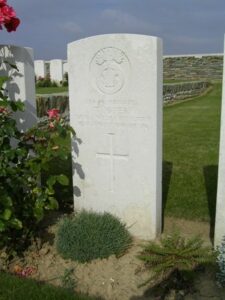
Thomas Rees Jones, Private, 46326, Welsh Regiment. Thomas was born in Llandovery in 1881. In 1908 he married Eliza Beatrice Penelrick, and the couple set up home at 2, Victoria Street, Llandingat, where their three children were born. Thomas enlisted at Llandovery into the 17th Battalion, Welsh Regiment, which was a Bantam battalion, attached to 119 Brigade, 40th (Bantam) Division. The Division moved to France in June 1916, and served at Loos until August, before moving to the Somme. They fought during the Battle of the Ancre, and followed the German retreat to the Hindenburg Line where Thomas was killed in action on 24 April 1917, aged 37. Thomas is buried at Fifteen Ravine British Cemetery, Villers-Plouich, France.
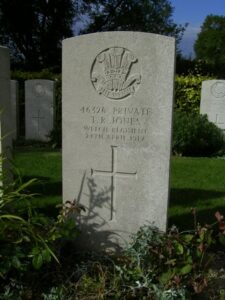
William Jones, Private, 292188, Royal Welsh Fusiliers. Willie was the son of John and Elizabeth Jones, of 3, Croft Cottages, Victoria Street, Llandovery. He enlisted at Llandovery into the army, and was posted to France sometime in 1917, where he joined the 14th Battalion, Welsh Regiment, which was attached to 113 Brigade, 38th (Welsh) Division. The Division had been in France since December 1915, and had spent their first winter in the trenches near Armentieres, before capturing Mametz Wood in July 1916. The Division suffered terrible casualties at Mametz, and were taken out of the line, and moved to Ypres to rebuild. Here they fought at Pilckem and Langemarck, then moved to Armentieres, where they remained from September 1917 until March 1918 when the German Spring Offensive was launched. The British had been over-run on the Somme, and so in April the Division was moved south, taking up positions North of Albert, from where they weathered the storm of the coming months, until the war turned during the Battle of Amiens, on 8 August 1918. The 38th Division launched its attack across the River Ancre on 21 August 1918, and over the coming days drove the Germans back across the old Somme battlefields. William was killed in Action near High Wood on 26 August 1918, aged just 21. He is buried at Caterpillar Valley Cemetery, Longueval, France.
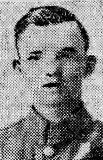
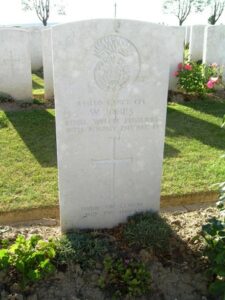
Aneurin Rhys Lewis, Gunner, 124040, Royal Garrison Artillery. Aneurin was the son of Charles William Rhys Lewis and Miriam Lewis, of Fronfelen, Llandovery. He enlisted at Oxford on 26 October 1916 into the Royal Fusiliers, but was discharged as unfit, and re-enlisted into the Royal Garrison Artillery. Aneurin was then posted to France, joining the 13th Siege Battery. Aneurin was killed in action during the opening day of the German Spring Offensive on 21 March 1918, aged 20. Aneurin was initially buried on the battlefield, but in 1920 his body was exhumed, and he was reburied at Gouzeaucourt New British Cemetery, France.
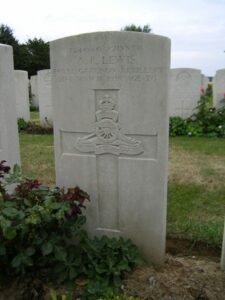
Thomas George Lewis, Gunner, 100593, Royal Garrison Artillery. Thomas was known by his middle name, George, and was born in Cilfynydd in 1895, the son of William and Margaret Lewis. The family came to live in St. Mary Street, Whitland, and George attended Whitland Council and County Schools, before taking up a post at Lloyd’s Bank in Llandovery. George was engaged to a Miss Thomas prior to enlisting at Llandovery into the Royal Garrison Artillery on 13 June 1916. He landed in France in June 1916 and was posted to the 48th Heavy Battery, which was part of the 3rd Brigade, R.G.A. Not much is known of where George fought except that during the spring of 1918 he was at Ypres. The German offensive of spring 1918 had been launched on 21 March 1918, and they turned their attentions to Flanders a month or so later. George was killed in action at Ypres on 30 May 1918, aged 22, and is buried at Canada Farm Cemetery, Belgium. Some time later, his mother received a letter from a Welsh Chaplain who was attached to the Brigade- ‘This is a great shock to you, and I hasten to convey to you personally, and on behalf of the battery to which your son was attached, our greatest sympathy. I understand that he was greatly respected and that his loss will be felt by all…’
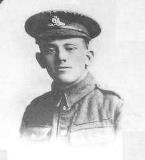
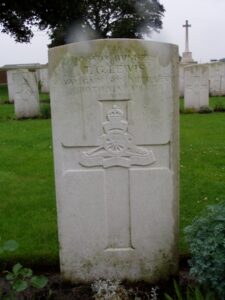
David Lloyd, Private, 438600, Canadian Expeditionary Force. David was born at Llanio, Cardiganshire on 8 November 1880, the son of Evan and Ruth Lloyd. Ruth died in 1888, and Evan moved the family to 20, Orchard Street, Llandovery. David had migrated to Canada prior to 1911 and worked as a Fireman. He enlisted there on 21 April 1915 into the Canadian Expeditionary Force. David embarked for England, and then moved to France where he joined the 52nd Battalion (North Ontario), Canadian Infantry, which was attached to 9 Brigade, 3rd Canadian Division. The Division assembled in France in December 1915, and they fought their first major at Mount Sorrel, near Ypres. This is where David was killed in Action, on 3 June 1916, aged 36. He is remembered on the Ypres (Menin Gate) Memorial, Belgium.
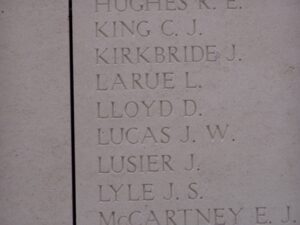
Walter Lovell, Private, 4337, Welsh Regiment. Walter was born at Llandyssul, and resided at Llandovery prior to the outbreak of war. He enlisted at Llandeilo into the 4th Battalion, the Welsh Regiment. The battalion was a reserve unit, stationed at Pembroke Dock. Walter became ill there, and died on 18 October 1916, aged 20. Walter is buried at Pembroke Dock Military Cemetery. He is not commemorated at Llandovery.
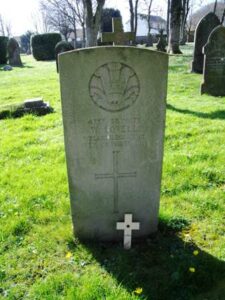
Patrick Manning, Private, 33779, Royal Welsh Fusiliers. Patrick was the son of Michael and Mary Manning. He married Hannah Jones on 7 May 1888, and the couple moved to Stone Street, Llandovery, with their eleven children. Patrick had served with the South Wales Borderers prior to moving to Llandovery, and at the outbreak of war re-enlisted at Carmarthen into the South Wales Borderers. Patrick was too old for active service, and was transferred to the 1st Garrison Battalion, Royal Welsh Fusiliers. The battalion landed at Gibraltar for Garrison duties on 23 August 1915. Patrick had been found unconscious at the Fish Market Road, Gibraltar by the Military Police on 14 May 1918 and was locked up after being deemed to have been drunk. On 15 May 1918 his lifeless body was found in the detention room at the Casemate Barracks, and the garrison doctor was called. A post mortem found his death to have been caused by severe head injuries, but due to insufficient evidence, failed to clarify the cause. Patrick was 51 years old, and is buried at Gibraltar (North front) Cemetery.
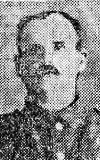
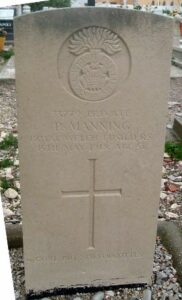
John Elias Morgan, Private, 12430, Royal Welsh Fusiliers. John was the son of Thomas and Elizabeth Morgan, of Garden Cottage, Queen Street, Llandovery. He enlisted at Ammanford into the 8th Battalion, Royal Welsh Fusiliers, who formed part of 40 Brigade, 13th (Western) Division. The Division was ordered to Gallipoli in June 1915, and in July landed at Cape Helles, then moved to ANZAC Cove on 3 August 1915. Here they fought at the Battles of Russell’s Top and Sari Bair, and John was killed in action here on 11 August 1915, aged 37. He is remembered on the Helles Memorial, Gallipoli.

Thomas Morgan, MM, Sergeant, 14735, South Wales Borderers. Thomas was the son of David and Ann Morgan, of Victoria Street, Llandovery. He enlisted at Brecon into the 1st Battalion, South Wales Borderers. The Battalion had landed at Havre on 13 August 1914, as part of 3 Brigade, 1st Division, and took part in the retreat from Mons to the Marne, before moving to Ypres, where they fought at First Ypres, and then at Aubers in early 1915. They took part in the Battle of Loos in September that year, and in 1916 fought on the Somme, from the Battle of Albert in July onwards, and were on the Ancre over the winter of 1916/17 and took part in the push to the Hindenburg Line in March 1917, before being posted to the Flanders Coast. They were rushed south to take part in Third Ypres. It was here, during the Second Battle of Passchendaele, that Thomas was wounded. He Died of Wounds on 10 November 1917 aged 28. He is remembered on the Tyne Cot Memorial, Belgium. Thomas was the holder of the Military Medal.
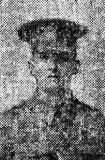
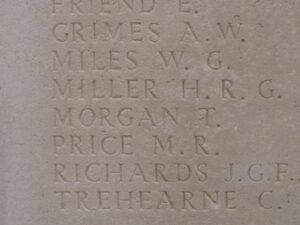
Robert Leslie Wilmott Nicholl, Private 17686, Welsh Regiment. Robert was the son of Edward Beynon Nicholl and Annie Winifred Nicholl, of Llwyncelyn, Llandovery. He was educated at Llandovery College, and enlisted at Swansea into the 14th Battalion, Welsh Regiment, which was attached to 114 Brigade, 38th (Welsh) Division. The Division had landed in France in December 1915, and moved to positions near Armentieres, where they were initiated into trench warfare. Robert was wounded here, and evacuated to the Base Hospital at Calais, where he died of wounds on 4 April 1916, aged only 19. He is buried at Calais Southern Cemetery, France.
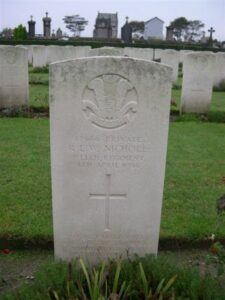
Wyndham Price Oxenham, Corporal, 7167, South African Infantry. Wyndham was born at Llandeilo, the son of Captain Charles Octavius Oxenham and Marian Oxenham. His grandfather, William Price, ran the Black Ox at Llandovery. The Oxenham family emigrated to Park Hill, Germiston, Transvaal, probably after the Boer War. Wyndham was a full time soldier, and had served with the Imperial Light Horse. At the outbreak of the Great War he was posted for service into the 5th Regiment, South African Mounted Rifles on 24 August 1914. Wyndham was killed in action on 25 November 1914 during the Battle of Rooidam. He was 23 years old and is buried in Rooidam Farm Cemetery, South Africa. Both of his brothers also served with the South African infantry, and their cousin, Ben Roberts of Llandeilo, also fell.
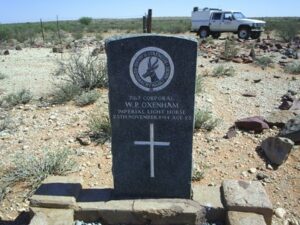
Edward Arnold Price, Private 260107, Cheshire Regiment. Edward was born in Llandovery, the son of Arthur and Wilhelmina Price. The family later resided at 281, Tarreni Terrace, Godrergraig, Swansea. He enlisted at Aberdare into the 13th Battalion, Cheshire Regiment, which was part of 74 Brigade, 25th Division. The Division crossed to France during September 1915, and were moved into positions near Vimy Ridge, where they remained until June 1916. They then moved south to Warloy, and they took part in an assault near Thiepval on 3 July 1916, and remained on the Somme until moving to Ploegsteert in November 1916. They fought during Third Ypres, at the Battle of Messines and then moved to Pilckem to take part in the assault there. Edward was killed in Action during at Ypres, on 10 August 1917, aged just 19, and is remembered on the Ypres (Menin Gate) Memorial, Belgium. Edward is not commemorated at Llandovery.
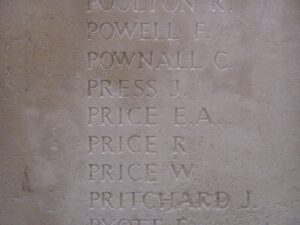
Edward John Lymington Price, Able Seaman, Z/236, Royal Naval Division. Edward was born at Llandovery on 15 March 1875, the son of John and Catherine Price. After 10 years service in the Mercantile Marine, by 1911 he was residing with his brother, George Penry Price, at High Pitfold Farm, Hindhead, Surrey. Edward enlisted, as a Royal Naval Reservist, into the Royal Naval Division, on 9 September 1914. He was posted to ‘B’ Company, Nelson Battalion, which formed part of 189 Brigade, 63rd (Royal Naval) Division. The Division had been formed at the request of Winston Churchill, to make use of the surplus of men in the Royal Naval Reserve. They saw action during the fall of Antwerp in 1914, and were sent to the Mediterranean, to take part in the Gallipoli landings of 25 April 1915. After landing, the Division suffered heavy casualties, but remained on the Peninsula, which is where Edward was wounded, being shot through both legs. He was transferred to the Hospital Ship Neuralia, where he died of wounds on 5 July 1915, aged 40. Edward was buried at sea, and is remembered on the Chatham Naval Memorial, Kent.
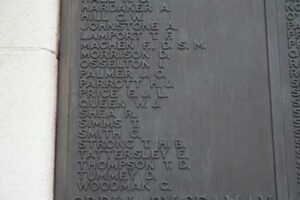
Edward Redding, Private, 6350, Welsh Regiment. Edward was born in London in 1878. He had moved to Carmarthenshire by 1901, and lived at Divlyn, Llandovery with his brother John. Edward enlisted at Llandeilo into the 2nd Battalion, Welsh Regiment, which was attached to 3 Brigade, 1st Division. The Division were one of the first in France landing on 13 August 1914. They immediately moved to Mons and took part in the Battle of Mons, before fighting in the epic retreat south toward the Marne, where the German Offensive was held. The Welsh took part in the advance to the Aisne, and fought at the Battle of the Aisne, before being moved to Ypres, where they took part in First Ypres, the battle which held the German advance across Flanders. Edward was wounded during the Battle of Gheluvelt, and Died of Wounds on 31 October 1914, aged 36. He is remembered on the Ypres (Menin Gate) Memorial, Belgium.
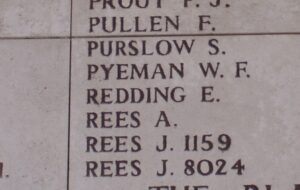
John Redding, Private, 6324, Welsh Regiment. John was born in London in 1874. He had moved to Carmarthenshire by 1901, and lived at Divlyn, Llandovery with his brother Edward. John enlisted at Llandeilo into the 2nd Battalion, Welsh Regiment, along with his brother, Edward. The battalion was attached to 3 Brigade, 1st Division. The Division were one of the first in France landing on 13 August 1914. They immediately moved to Mons and took part in the Battle of Mons, before fighting in the epic retreat south toward the Marne, where the German Offensive was held. The Welsh took part in the advance to the Aisne, and fought at the Battle of the Aisne, before being moved to Ypres, where they took part in First Ypres, the battle which held the German advance across Flanders. John was probably wounded at Loos in September 1915. He was brought back to a hospital in North Wales, where he became attached to the 3rd Welsh, and died there on 2 January 1916, aged 42. He is buried at Bangor (Glanadda) Cemetery.
Albert Lloyd Rees, Lieutenant, Royal Welsh Fusiliers. Albert was the son of John and Charlotte Rees, of Y Fron, Llandovery, and he enlisted at Llandovery into the Pembroke Yeomanry in March 1915. He was commissioned into the 1/6th Battalion, Royal Welsh Fusiliers, who were attached to 158 Brigade, 53rd (Welsh) Division. The Division had landed in Gallipoli on 8 August 1915, and fought there until being evacuated in December, after suffering heavy casualties. They then moved to Egypt, before taking part in the advance into Palestine from March 1917. Albert visited the grave of his younger brother, John, at Egypt, before being killed in Action on 6 November 1917, during the Third Battle of Gaza. He was 27 years old, and is buried at Beersheba War Cemetery, Israel. His brother, John Cyril Rees, died at Gallipoli.
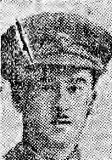
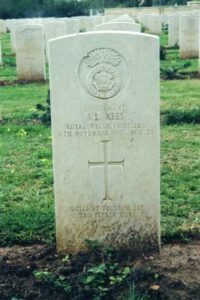
John Cyril Rees, Second Lieutenant, Welsh Regiment. John was the son of John and Charlotte Rees, of Y Fron, Llandovery. He lived with his wife Louisa Elizabeth Rees, at Velindre, Llandovery. John was commissioned into the 3rd Battalion, Welsh Regiment, which was a Home Service unit, but was attached to another unit, probably the 1/4th Welsh, and served at Gallipoli. John was wounded at Gallipoli, and shipped back to the Military Hospital at Alexandria, where he died of wounds on 6 November 1915, aged 24. He is buried at Alexandria (Chatby) Military Cemetery, Egypt. His brother Albert also fell.
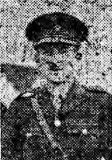
Laurence Sinclair Rees, Second Lieutenant, Welsh Regiment. Laurence was born at Llandovery, the son of Thomas and Mary H. Rees. His brother, Conway Rees, had played rugby for Wales. The family later resided at Trehyfryd, Wexham, Slough, Bucks. He was commissioned into the 13th Battalion, the Welsh Regiment, which was attached to 114 Brigade, 38th (Welsh) Division. The Division had landed in France during December 1915 and had spent their first winter in the trenches near Armentieres. In June they marched south to the Somme, where they were tasked with the capture of Mametz Wood. The attack on the wood began on 7 July 1916, but met with fierce resistance, and it took almost four days to clear the wood. Laurence was killed in action during the attack of 10 July 1916, aged 26, and is remembered on the Thiepval Memorial, France.
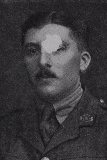
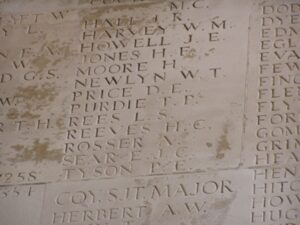
Daniel Richards, Rifleman, R/9943, Kings Royal Rifle Corps. Daniel was the son of David and Sarah Richards, of Plasnewydd, Cilycwm, Llandovery. He enlisted at Ammanford into the 9th Battalion, Kings Royal Rifle Corps, who formed part of 42 Brigade, 14th (Light) Division. The Division had landed at Boulogne on 20 May 1915 and fought at Hooge, where they were to gain the dubious honour of being the first Division to be attacked by flamethrowers. Daniel was wounded there by shrapnel, and returned home for treatment, but died in hospital at Bury St Edmunds of wounds on 25 October 1915, aged 24. He was given a military funeral at Cilycwm Baptist Chapelyard.

David Richards, Private 200912, Welsh Regiment. David was the son of John and Ann Richards, of 10, Castle Street, Llandovery, and enlisted at Llandovery into the 1/4th Battalion, the Welsh Regiment, which was part of 159 Brigade, 53rd (Welsh) Division. The Division had landed in Gallipoli on 8 August 1915, and fought there until being evacuated in December, after suffering heavy casualties. After over a year in Egypt, they took part in the offensive in Palestine. David was wounded during the First Battle of Gaza. He died of wounds on 9 April 1917, aged 26 and is buried at Kantara War Memorial Cemetery, Egypt.
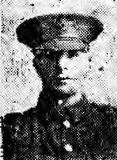
Robert Hugh Owen Roberts, Lieutenant, Australian Infantry. Robert was born at Queensland, Australia in 1895, the son of Lewis and Elizabeth Roberts. By 1901 the family had returned to Lewis’s native Llandovery, and bought the Golden Lion Hotel. After being educated at Llandovery College, Robert returned to Australia, where he worked as a Schoolteacher, and he enlisted at Blackstone, Queensland, as a Private into the 41st Battalion, Australian Imperial Force. He embarked at Sydney on 18 May 1916 and arrived at Plymouth on 20 July 1916. Robert was soon promoted to Lance Corporal. On 24 November 1916 he joined his Battalion in France, where they were part of 11 Brigade, 3rd Australian Division. Robert was promoted to Corporal on 10 April 1917 but was wounded two weeks later, being shot in the jaw. After recuperating in England he was promoted to 2nd Lieutenant on 1 December 1917, and rejoined his Battalion on 28 December. He attended a Lewis Gun Course in January 1918. The 3rd Australian Division was in the thick of the action for most of 1918, and it was partly due to their actions on 8 August 1918 that the German Offensive was finally stopped dead at the Battle of Amiens, at Villers Brettoneux. Robert was Wounded in Action and died on 8 August 1918, aged 24. He was buried at Vaire Wood British Cemetery near Corbie, but his body was later re-interred at Villers Brettoneux Military Cemetery, Fouilloy, France. He was fondly known among his men as Bluey Roberts.
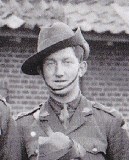
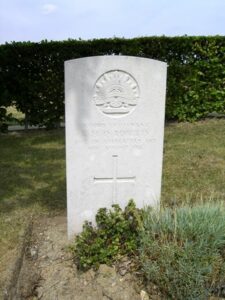
Sydney Roberts, Private, 23374, Royal Fusiliers. Sydney was the son of Councillor Thomas Roberts, J.P., and of Margaret Roberts, of Crown Stores, Llandovery. He had moved to Port Talbot prior to the war, where he worked as a Bank Clerk, and he enlisted there into the 7th Battalion, Royal Fusiliers. The Battalion landed at Havre on 24 July 1916 and were then attached to 190 Brigade, 63rd (Royal Naval) Division. The Division had just landed in France from Gallipoli, and they fought a famous action during the end of the Somme offensive at the Battle of the Ancre. They remained on the Ancre throughout the winter of 1916/17, which is where Sydney was killed in action on 8 February 1917, aged 27. He is buried at Queen’s Cemetery, Bucquoy, France.
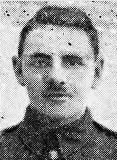
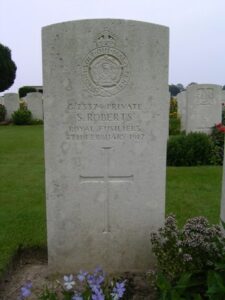
James Henry Slater, Private, 35905, Worcestershire Regiment. James was born at Dudley Wood, Staffordshire, and had moved to Llandovery prior to the war. He enlisted at Birmingham into the 2nd Battalion, the Worcester Regiment, which was attached to 100 Brigade, 33rd Division. The Battalion had been in France since August 1914, and had fought in the defence of Ypres in 1914, where they helped save the City from German capture. After joining the Division in December 1915, they fought at the Battles of the Somme, from July 1916 onwards. They then fought at the Battle of the Scarpe and at Bullecourt, before heading to Ypres, and fighting at the Menin Road and at Polygon Wood. They were still in Flanders when the German Spring Offensive hit, and after the Germans had been halted, were brought to the St. Quentin area, where James was Killed in Action during the Battle of the St. Quentin Canal, on 29 September 1918. He is buried at Pigeon Ravine Cemetery, Épehy, France. James is not commemorated at Llandovery.
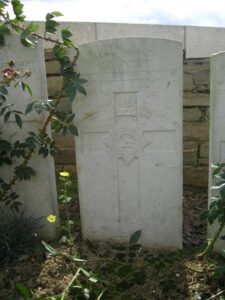
John E. Smith, Private, 53327, Cheshire Regiment. John was born at Northampton in 1881, but was orphaned while young, and resided at Pontgareg, Llandovery prior to the war. He enlisted at Ammanford on 8 February 1915 into the 15th Battalion, Welsh Regiment, which was known as the Carmarthen Pals battalion. The battalion was attached to 114 Brigade, 38th (Welsh) Division, and landed in France in December 1915. After being initiated into trench warfare in the Fleurbaix sector, the division made its famous attack on Mametz Wood on 7 July 1916, capturing the wood after days of heavy fighting. The following year the division captured Pilckem Ridge. John was wounded at Pilckem, and returned home for treatment. On 31 March 1918 John transferred into the 11th Battalion, the Cheshire Regiment, which was attached to 7 Brigade, 25th Division. The Division was used to reinforce the badly depleted British units that were hit in the area by the German Spring Offensive of 21 March 1918. It then moved north to Flanders, and fought at Estaires, Bailleul, Messines and Kemmel, before moving to the Aisne at the beginning of May to recuperate from their ordeal. John was wounded here and transported to the Base Hospital at Boulogne, where he died on 14 May 1918, aged 37. He is buried at Boulogne Eastern Cemetery, France.
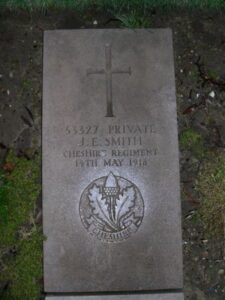
David Albert Stephens, Able Seaman, Z/825, Royal Navy. David was born on 16 June 1877, the son of Thomas and Jane Stephens, of Llandovery. He married in 1900, and lived with his wife, Catherine Stephens, at 1, Amberton Place, Penydarren, Merthyr Tydfil. David served in the Royal Navy aboard the Battlecruiser H.M.S. Invincible, which was the Flagship of the Third Battlecruiser Squadron. The Invincible fought at the Battle of Jutland on 31 May 1916, and was sank by a salvo from the SMS Lutzow, which hit ‘Q’ Turret of the Invincible, causing a flash explosion which entered the magazine, and tore the Invincible in two. She sank with all but six of her crew. David was one of those poor souls killed that day. He was 38 years old, and is remembered on the Plymouth Naval Memorial, Devon.
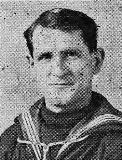
Edward Stirling, Private, 22691, Welsh Regiment. Edward was living at Llandovery prior to the war, and was recalled to the colours in August 1914, rejoining the 2nd Battalion, Welsh Regiment at Cardiff. The Battalion landed in France on 13 August 1914 as part of 3 Brigade 1st Division, and fought at the Battle of Mons, and during the epic retreat to the Marne, where the German Advance was halted. After taking part in the Battle of the Aisne, the Division moved to Ypres, where it held the City during First Ypres and prevented its capture. After a hard winter in Flanders, the Division fought at the Battle of Aubers Ridge, where Edward was killed in Action on 9 May 1915. He is remembered on the Le Touret Memorial, Richebourg L’Avoue, France. Edward is not commemorated at Llandovery.
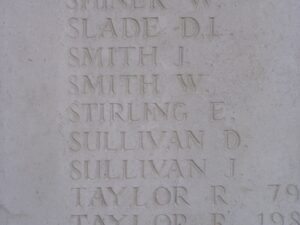
Herbert Gordon Thomas, Second Lieutenant, Royal Welsh Fusiliers. Herbert was born at Llandovery in 1885, the son of the Rev. Thomas Thomas and Mary Ann Thomas. The family later resided at the Vicarage, Abergwili. Herbert was educated at Llandovery College, before being commissioned into the 3rd Battalion, Royal Welsh Fusiliers. He was posted to France, where he joined the 10th Battalion, Royal Welsh Fusiliers, which was attached to 76 Brigade, 3rd Division. On 13 November 1916, the 10th RWF attacked the strongly defended village of Serre, in the northern sector of the Somme. Most of the officers in the leading waves were killed, including Herbert, who was killed on 13 November 1916, aged 31. He is buried in Euston Road Cemetery, Colincamps, France. Herbert is not commemorated at Llandovery.
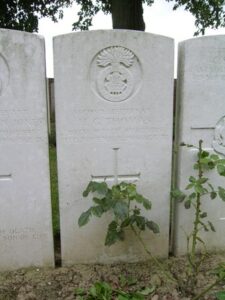
William Rhys Thomas, Private, 267172, Welsh Regiment. William was the son of Richard Morris Thomas and Elizabeth Ann Thomas, of 72, High Street, Llandovery. He enlisted at Llandovery into the army, and was posted to France sometime in 1917, where he joined the 15th Battalion, Welsh Regiment, known as the Carmarthen Pals battalion, which was attached to 114 Brigade, 38th (Welsh) Division. The Division had been in France since December 1915, and in July 1916 had captured Mametz Wood. The Division suffered terrible casualties at Mametz, and were taken out of the line, and moved to Ypres to rebuild. The Third Battle Ypres was launched on 31 July 1917, and the 38th Division captured Pilckem Ridge from the Prussian Guards. After Third Ypres, the Division were moved to the Armentieres area, where they remained until moving to the Somme, to a position North of Albert, where they reinforced the badly depleted British forces defending the route to Amiens. William was killed in Action during the Battle of Albert, on 23 April 1918, aged 21. He is remembered on the Pozières Memorial, France.
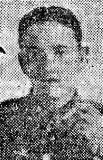
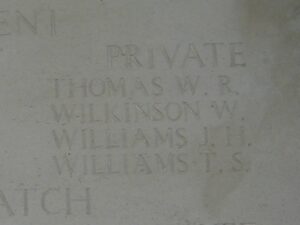
World War Two, 1939-1945
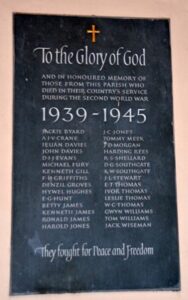
Joseph Henry (Jackie), Byard, Sergeant, 4924510, Royal Artillery. Jackie was the son of Henry John and Catherine Byard, of Birmingham and the husband of Edith Lilian Byard, of Bourneville, Birmingham. He served in the Royal Artillery, with 4th Airlanding Anti-Tank Battery, which was part of the 5th Parachute Brigade, 6th Airborne Division. The Brigade was dropped into Normandy on 6 June 1944 to support the landings on the British beaches, by landing behind Sword Beach, to secure the eastern flank. The objectives of the Division were to capture Pegasus Bridge, the bridge over the Orne River, and the destruction of the Merville Battery, as well as the consolidation of the areas around Ranville. The 4th Airlanding Battery landed in a Horsa Glider at LZ-N, and proceeded to clear the area of obstacles for the second landing force, and they settled into defensive positions. Jackie was killed in Action the day after D-Day on 7 June 1944, during the frantic German counter-attacks, and is buried at Ranville War Cemetery, France. He was 33 years old.
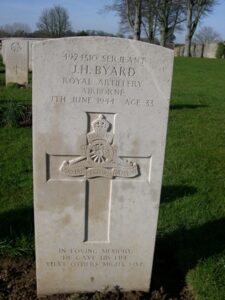
Alfred John Vaughan Crane, Sergeant (Pilot), 1809343, Royal Air Force Volunteer Reserve. Alfred was born on 16 September 1924, the son of Richard Henry and Edith Jane Crane, of Llandovery. After leaving Llandovery Grammar School he served with the 11th Battalion (Durham) Home Guard, before joining the Royal Air Force, and training as a Pilot. He was killed on active service in India on 29 January 1945, aged 20, and is buried at Kirkee War Cemetery, India.
David John Davies, Sergeant, 1315214, Royal Air Force Volunteer Reserve. David was the son of John and Eleanor Mary Davies, of Llandovery, and served as a Wireless Operator/Air Gunner with 37 Squadron, RAF. The Squadron flew the Vickers Wellington X, based at Tortorella, where they flew in the Middle Eastern theatre, and upon the invasion of Italy, the Squadron flew missions from bases there over occupied Eastern Europe. David was killed on 25 May 1944 and is buried at Moro River Canadian War Cemetery, Italy. He was just 22 years old.
Ieuan Davies. Ieuan cannot be identified.
William Oswald Davies, Private, 4192228, Highland Light Infantry (City of Glasgow Regiment). William was the son of John and Catherine Davies of Llwynhowell. He served with the 2nd Battalion, Highland Light Infantry, which was in Palestine in 1939. The battalion moved to Egypt, and took part in the campaign in North Africa and the Western Desert. The battalion took part in the landings at Sicily in 1943. William was killed in Italy on 22 September 1944. He was 27 years old, and is buried at Mierlo War Cemetery, Italy. William does not seem to be commemorated locally.
David Ivor James Evans, Sergeant (Nav/Bomber), 1338188, Royal Air Force Volunteer Reserve. David was a Navigator/ Bomber with 103 Squadron, RAF, which flew the Avro Lancaster III, based at Elsham Wolds. On the night of 26 November 1943, 450 aircraft took off from England bound for Berlin and Stuttgart. David’s Lancaster was shot down on the outward journey, and he was killed that night, on 26 November 1943 and is buried at Durnbach War Cemetery, Germany.
Michael Fury. Michael cannot presently be identified, but he appears to have been born in Merthyr in 1912, the son of Michael Martin Fury and Annie Fury (nee McDonald). The family later resided at 6, Church Bank, Llandovery.
Kenneth Stanley Gill, Steward, Merchant Navy. Kenneth was born at Llandovery on 20 September 1916, the son of Robert Gill and Alice Gill (nee Pearce). He served with the Merchant Navy aboard the SS Oropesa, a Liverpool registered passenger liner. On 16 January 1941, while sailing independently on government service on a voyage from Mombasa to the UK, with 41 passengers, and a cargo of copper and maize, Oreposa was torpedoed and sank by the German submarine U-96 in the Atlantic, South-East of Rockall. One hundred and six lives were lost, including Kenneth. He was 24 years old, and is commemorated on the Tower Hill Memorial, London.
Frederick Howard Griffiths, Sub-Lieutenant, Royal Naval Volunteer Reserve. Frederick was the son of David and Marion Griffiths, of Llandovery, and he served at H.M.S. Quebec. Quebec was not a ship, but was part of the No. 1 Combined Training Centre, with the role of providing craft for training of the British Special Forces. Frederick must have been part of the forces that invaded North Africa as part of Operation Torch, and subsequently took part in the invasion of Italy, where Frederick died on 21 June 1944, aged 25. He is buried at Biguglia War Cemetery, Tunisia.
Denzil Walter Charles Groves, Sergeant, 615602, Royal Air Force. Denzil was the son of George Samuel and Rosamond Groves of Llandovery, and the husband of Gwendoline Myra Stephenson Groves, of Kilburn, Middlesex. He was a Sergeant Pilot with 154 Squadron, RAF, which flew the Supermarine Spitfire IIA, based at Fowlmere. Denzil died on 11 December 1941, and is buried at Llandingat (St. Dingat) Churchyard. He was 31 years old.
William John Howell Hughes, Gunner, 890726, Royal Horse Artillery. William was the son of William and Mary Lizzie Hughes, of Llandovery, and the husband of Lilian Eirwen Hughes, of Llandovery. He served with the 107 (The South Notts. Hussars) Medium Regiment, Royal Artillery, which was equipped with 25 pounder field guns. They went to the Middle East in 1940, and were trapped in the siege of Tobruk with the Australian infantry. They later fought at El Alamein and were withdrawn to the UK in 1944, from where they moved to Normandy, and fought up through France, Belgium & Holland into Germany. William was killed on 2 June 1945, aged 30 and is buried at Reichswald Forest War Cemetery, Germany.
Edmund George Hunt, GM, Warrant Officer, 359883, Royal Air Force. Edmund was born in Tisbury, Wiltshire in 1906, the son of Edmund and Annie Hunt. At some time around 1914 the family moved to Llandovery. Edmund married Phylis Havelock, of Medway, Kent in 1929. He was serving as an armourer with the Royal Air Force when war broke out. He put his skills with weapons to good use during the Battle of Britain, working on Bomb Disposal, and for his good work during the Battle of Britain, was awarded the George Medal: ‘This Warrant Officer has dealt with unexploded bombs after six enemy bombing attacks on the aerodrome. On one occasion, while assisting an officer he was blown 20 yards; but in spite of this he has continued to show a complete disregard for his own safety and his gallant actions have been instrumental in keeping the aerodrome operationally serviceable’. Edmund was killed while attempting to defuse a German bomb at Biggin Hill on 7 October 1940, aged 34. He is buried in Chatham (Palmerston Road) Cemetery, Kent. Many thanks to Kathy Lewin for identifying Edmund for me, and also for the photograph of him.
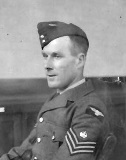
Ellen Elizabeth ‘Betty’ James, Leading Aircraftwoman, 2037244, Women’s Auxiliary Air Force. Betty was the daughter of Thomas George and Amy James, of Llandovery, and died at Ely, Cambridgeshire on 30 June 1947, aged just 21. She is buried at Llandingat (St. Dingat) Churchyard.
Kenneth James, Gunner, 1096410, Royal Artillery. Kenneth was the son of John and Edith May James, of Llandovery. The family moved around the country prior to the war, as John worked with the railways. Kenneth enlisted into the Royal Artillery, and served with 51 (The Westmorland and Cumberland Yeomanry) Field Regiment, Royal Artillery. During World War II the regiment served in Norway, on detachment from the 42nd (East Lancashire) Division. After the evacuation of Norway they moved to the Western Desert, serving with the 7th Armoured Division (Desert Rats) in November 1941. Kenneth was killed in North Africa on 23 December 1941. He was 25 years old, and is commemorated on the Alamein Memorial, Egypt. Within days his brother Ronald also fell. Many thanks to Clive Simons for identifying the two brothers, and for the photographs.
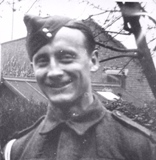
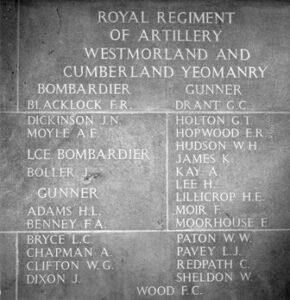
Ronald James, Sergeant, 917059, Royal Air Force Volunteer Reserve. Ronald was the son of John and Edith May James, of Llandovery. The family moved around the country prior to the war, as John worked with the railways. Ronald enlisted into the Royal Air Force Volunteer Reserve, and after training as a Wireless Operator/ Air Gunner, was posted to 405 Squadron, Royal Canadian Air Force. The Squadron was equipped with the Vickers Wellington II. On 28 December 1941, Ronald took off from RAF Topcliffe, as part of a large bomber force, which was to attack three targets in Germany, at Wilhelmshaven, Huls and Emden. His Wellington must have been brought down over Germany that night, as Ronald was killed on 28 December 1941. He was 22 years old, and is buried at Sage War Cemetery, Germany. His brother Kenneth had been killed just five days previously. Many thanks to Clive Simons for identifying the two brothers, and for the photographs.
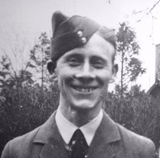
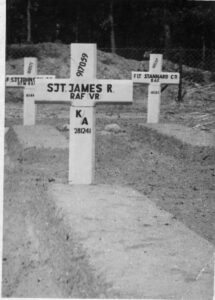
Evan Morgan Jones, Fireman, Auxiliary Fire Service. Evan was born at Llandingat, and lived at 3, Old Kent Road, Southwark. He was the son of Mr. William Jones and Mrs, Anne Jones, of 196 New Road, Chingford, Essex, and served with the Auxiliary Fire Service, based at the Metropolitan Borough of Lambeth, in London. On the night of 10/11 May 1941, happened what turned out to be one of the worst nights of the war for London. The Germans timed the raid to coincide with an exceptionally low tide on the Thames, which meant that there was little water for fire fighting. Evan was injured during the Air Raid, and died the same day at St. Thomas’s Hospital on 11 May 1941. He was 34 years old, and is buried at Lambeth Cemetery. His brother Francis also fell. Neither brother is commemorated at Llandovery.
Francis Eric Jones, Sergeant, 5115623, Royal Warwickshire Regiment. Francis was born at Llandingat, the son of William Jones, and of Anne Jones, of Chingford, Essex. He served in the 2nd Battalion, Royal Warwickshire Regiment, who landed on Normandy, at Queen Beach, a sub-division of Sword, on D-Day, 6 June 1944. Francis was killed in Action that first day of the landings, aged 27, and is remembered on the Bayeux Memorial. His brother Evan also died as a result of the war. Neither brother is commemorated at Llandovery.
Harold Bowen Jones, Warrant Officer (Air Bomber), 1324221, Royal Air Force Volunteer Reserve. Harold was the son of David and Elizabeth Maud Jones, of Llandovery, and the husband of Winifred Olive Bowen Jones, of Ford, Buckinghamshire. He was posted to 1660 Heavy Conversion Unit at RAF Swinderby in Lincolnshire. On the afternoon of 25 February 1945 Harold was a crew-man aboard Lancaster ME490, which took off on a training flight to demonstrate three-engine landings. After shutting off one engine the Lancaster attempted to land, but stalled and crashed, killing six of her crew of seven men. Harold was 29 years old when he was killed in the crash, and is buried at Llandingat (St. Dingat) Churchyard.
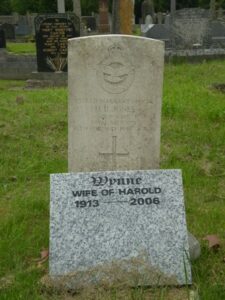
John Gwynfor Jones, Private, 4036611, Parachute Regiment. John was the son of John and Sarah Jones, of Pantybedw, Gwynfe. He enlisted into the King’s Shropshire Light Infantry and was part of a number of men posted to the 7th Battalion, Parachute Regiment which was part of the 3rd Parachute Brigade, 6th Airborne Division, on 3 July 1944, to make up losses suffered following the D-Day landings. John fought with the battalion throughout the remainder of the Normandy campaign and in September returned to Britain where he qualified as a parachutist, and returned to action during the Ardennes campaign. On 24 March 1945 John took part in the final mass allied parachute and glider assault of World War II, Operation Varsity, and by 7 April his battalion reached Petershagen, between Osnabrück and Hanover, before advancing towards Neustadt by motor transport. John was among a number of men killed during heavy fighting around Wunstorf Airport at some time during the night. He was 28 years old and is buried in Becklingen War Cemetery. Neustadt and its river crossing over the Rhine were successfully captured during the following days, enabling the Allies to advance into the heartland of Germany.
William Henry Lloyd, Gunner, 327939, Royal Artillery. William was born at Llandovery in 1917, and lived with his wife, Mrs G. Lloyd, at Maidstone, Kent. He was based at Edinburgh with the Royal Artillery during the war, and died on active service on 31 January 1942, aged 24. William is buried at Edinburgh (Comely Bank) Cemetery, Scotland. William is not commemorated at Llandovery.
Havelock McCreadie, Staff Sergeant, 876222, Royal Army Ordnance Corps. Havelock was born at Llandovery in 1921, the son of Thomas and Sylvia Ellen McCreadie (nee Hughes). He lived with his wife, Constance Isabella McCreadie, at Ashington, Northumberland. Havelock served with the Royal Army Ordnance Corps, and landed in Normandy in June 1944. He was killed on 3 August 1944, aged 23, and is buried at Bayeux War Cemetery, France. Havelock is not commemorated at Llandovery.
Thomas John Meek, Sergeant, 4074451, South Wales Borderers. John was the son of Thomas and Jane Meek, and the husband of Johanna Myfanwy Meek, of Llandovery. He served with the 2nd Battalion, South Wales Borderers, which had the distinction of being the only Welsh unit to land on D-Day, as part of the 7th Armoured Division, under the Command of XXX Corps. Thomas was killed in Normandy on 29 August 1944, aged 37, and is buried at St. Desir War Cemetery, France.
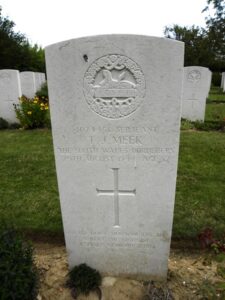
John Derek Morgan, Flying Officer, 153439, Royal Air Force Volunteer Reserve. John was born at Stockport, Cheshire in 1923, the son of Evan Dulais Morgan and Emilie Morgan. His father was from West Wales, but the family’s ties with Llandovery are unclear, and they later resided at Hereford. John joined the Royal Air Force, and trained as an observer before being posted to 29 Squadron, RAF. The squadron flew the de Havilland Mosquito from RAF Hunsdon, in Hertfordshire. On 2 December 1944, John was flying over aboard Mosquito MM519, piloted by Captain John Frederick Kinnery, on a night intruder patrol to Lippstadt. The aircraft crashed into the IJsselmeer, whilst en-route, killing both men. John was 21 years old, and is commemorated on the Runnymede Memorial, Surrey. His pilot, John Kinnery, is buried in Harderwijk General Cemetery after his body was found washed ashore.
David Robert Harding Rees, Flight Sergeant, 1337828, Royal Air Force Volunteer Reserve. David was known by his middle name of Harding, and was the son of George Penry Rees and Dorothy Wynford Rees, of Llandebie. George worked as a Signalman with the GWR at Llandovery for some years, and so the family were well known in the area. Harding served with 78 Squadron, RAF, which flew the Handley Page Halifax III, based at Breighton. 78 Squadron took part in a massed bomber raid on Berlin on 28 January 1944, and 49 out of a total of 677 aircraft were lost. Harding’s Halifax was shot down over the North Sea, probably on the return journey from the mission, and the entire crew were lost. Harding was just 22 years old, and is remembered on the Runnymede Memorial, Surrey.
Douglas Harry Search, Private, 5445316, Duke of Cornwall’s Light Infantry. Douglas was the son of Harry Samuel and Elsie Maud Mary Search, of Llandovery, and served with the 2nd Battalion, Duke of Cornwall’s Light Infantry, which were with the BEF in France at the outbreak of war. They later fought at North Africa, before taking part in the invasion of Italy, where Douglas was killed on 9 April 1944, aged 22. He is buried at Cassino War Cemetery, Italy. Douglas is not commemorated at Llandovery.
Roy Stephen Shellard, Warrant Officer Class II, 3955961, Welch Regiment. Roy was born on 10 September 1909, the son of William Henry Shellard and Edith Anne Price Shellard, of 17, West Street, Baneswell, Newport. He was educated at Llandovery College and married Elsie Helena Price in 1934. Roy served with the 1st Battalion, the Welch Regiment. The 1st Welch were serving in Palestine at the outbreak of war, as a peace keeping force, then were posted to the Western Desert, arriving at Mersa Matruh during November 1939. Before they had a chance to take on the Italians in North Africa, they were sent to Alexandria and when the threat to the British refuelling bases at Crete became serious, were sent to reinforce the garrison on the island. On 14 May 1941, the German onslaught against Crete began. The island was saturation bombed by 600 Luftwaffe aircraft, softening up the British defences before the German airborne assault was launched. Waves of Junkers 52 troop carrier aircraft and gliders brought German paratroopers to the battle, and by pouring in reinforcements the Germans were virtually in control of the island within a week. The 1st Battalions’ last stand in Crete came on 28 May 1941, when 9 German battalions overwhelmed them. Some 300 survivors reached the British naval base at Sphakia, where they were evacuated to Alexandria. Roy was killed in Action sometime between 24 and 27 May 1941, and is remembered on the Athens Memorial, Greece. He was 31 years old.
Albert Kenneth Southgate, Private 3963228, King’s Own Royal Regiment (Lancaster). Albert was the son of Joseph Thomas Southgate and Edith Southgate, of Llandovery. He married Ceinwen Mary Davies, of Llandovery, in 1936. He served with the King’s Own Royal Regiment, and died at home on 17 February 1945, aged 26. He is buried at Llandovery (Ebenezer) Baptist Chapelyard. His cousin David died in 1947.
David Gwyn Southgate, Private S/14697846, Royal Army Service Corps. David was the son of William and Margaret Southgate, of Llandovery. He served with the Royal Army Service Corps, and died at Swansea on 23 June 1947. He is buried at Llandovery (Ebenezer) Baptist Chapelyard. His cousin Albert had died earlier in the war.
John Logan Stewart, Captain, 52709, Kings Own Scottish Borderers. John was the son of Major William Edmond Stewart, DSO, and Mary Adela Morland Stewart, of Llandovery, and he served with the 1st Battalion, Kings Own Scottish Borderers. The KOSB were part of the 3rd Infantry Division with the BEF in France in 1940, and it was during the actual evacuation from the beaches at Dunkirk that John was Killed, aged 29, sometime between 31 May and 2 June 1940. He is remembered on the Dunkirk Memorial, France.
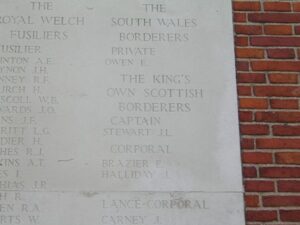
Evan Thomas Thomas, Lance Corporal, 3525351, Manchester Regiment. Tom was born at Water Street, Llandovery, the son of David and Alice Thomas. He served with the 1st Battalion, Manchester Regiment, which sailed for Singapore on 4 October 1938, and arrived there on 20 October. The battalion was assigned to a beach defence role tasked with building defences on the beaches to guard against a Japanese invasion, but when the Island was invaded by the Japanese in 1942, they came over by land, not by the expected sea. After a terrible fight for Singapore, the order to surrender came on 15 February 1942. Tom was one of thousands of men captured by the Japanese, and forced to march to the notorious Changi Jail. On 24 April 1943, over 300 survivors of the Manchester’s embarked on a forced march of almost 200 miles through the steamy jungle, where they were set to work on the Burma Railway. Tom died of sickness whilst a POW on 8 August 1945, aged 37, and is buried at Thanbyuzayat War Cemetery, Myanmar.
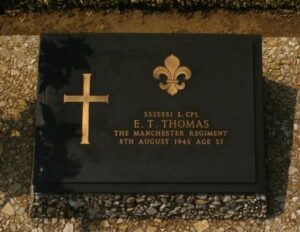
Ivor Gwynne Thomas, Able Seaman, D/JX 140205, Royal Navy. Ivor was born in Llandovery on 14 March 1917. He enlisted into the Royal Navy prior to the war and served aboard the aircraft carrier, HMS Glorious. She had originally been built as a battlecruiser during World War One and had taken part in the Second Battle of Heligoland Bight in November 1917. During the late 1920’s she was converted into an aircraft carrier and spent most of her career operating in the Mediterranean. After the start of the Second World War, Glorious spent the rest of 1939 unsuccessfully hunting for the German cruiser Admiral Graf Spee in the Indian Ocean before returning to the Mediterranean. She was recalled in April 1940 to support British operations in Norway. While evacuating British aircraft from Norway on 9 June 1940, Glorious was intercepted and sunk by the German battleships Scharnhorst and Gneisenau in the North Sea with the loss of over 1,200 lives. Ivor was 23 years old when he died that day and is commemorated on the Plymouth Naval Memorial, Devon.
Leslie Thomas, Able Seaman, D/JX212822, Royal Navy. Leslie was the son of Jonah and Annie Thomas, of Llandovery, and he served at H.M.S. Sultan, which was the Royal Naval Base at Singapore. After the fall of Singapore, many men were captured and fell into Japanese captivity. Leslie died as a POW on 2 March 1945, aged 25, and is buried at Jakarta War Cemetery, Indonesia.
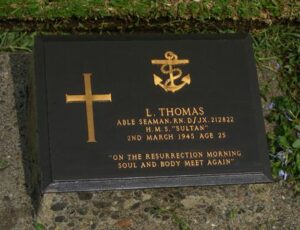
William Glynne Thomas, Lieutenant, 177759, Welch Regiment. William was born on 16 April 1920, the son of William Nicholas Thomas and Lilian Thomas (nee Evans), of Llandaff House, 9, Stone Street, Llandovery. He worked as an Estate Agents Articled Clerk prior to gaining a commission as Second Lieutenant into the Welch Regiment, and was posted to the 1st Battalion the Welch Regiment. The Regiment had been almost wiped out during the Battle of Crete in May 1941, when it was overwhelmed by nine German battalions. Somme 300 survivors reached the British naval base at Sphakia, where they were evacuated to Alexandria. The 1st Welch and the 1st South Wales Borderers were now up against the German Afrika Korps. On 16 June a strong panzer attack was made on the battalion’s position at Sidi Rezegh, and after a terrible time spent defending their positions, the 1st SWB were ordered to withdraw to Sollum on 17 June. The withdrawing troops ran straight into a German attack, 30 panzers and massed German infantry drove them into trap, and 14 officers and 500 other ranks were reported missing. Only four officers and 100 men survived. Meanwhile the 1st Welch were involved in the fierce struggle to hold Benghazi throughout January 1942, but were ordered to withdraw to the Egyptian frontier. The Welch battalions had been split into individual companies during the withdrawal, and met with vastly differing levels of success-many were wiped out by the Germans. Of the 700 odd officers and men of the 1st Welch who fought at Benghazi, only 214 survived. The survivors of the battalion were sent to Khartoum, where it refitted and was brought back up to strength, and then was sent to Palestine to train for the invasion of Italy, landing in July 1944 and joining the fighting on the Rimini Line. William was killed near the Senio River in Italy on 6 December 1944. The 24-year-old is buried in Bari War Cemetery.
Joseph Wells, Aircraftman 1st Class, 617573, Royal Air Force. Joseph was born at Llandovery in 1921, the son of Joseph Wells, and Sarah Kennedy. He was educated at Llandovery Grammar School, before enlisting into the Royal Air Force. Joseph served with 22 Squadron, Royal Air Force, which was an anti-submarine unit, equipped with the Bristol Beaufort. On 16 April 1940 Joseph was flying as a crewman aboard the Bristol Beaufort I, Serial L4465, on a mine-laying mission, when the aircraft suffered engine failure and crashed into the sea. All four of the crew were killed, two being washed ashore and buried. Sadly Joseph and another crew member were never found, and they are commemorated on the Runnymede Memorial, Surrey. Joseph is not commemorated at Llandovery.
Gwyn Williams. This man cannot presently be identified.
Thomas David Williams, Gunner, 897564, Royal Artillery. Thomas was the son of David and Mary Anne Williams, of Llandovery. He served in the Royal Artillery and was attached to the 78th Division HQ staff. The Division had been raised especially for the invasion of North Africa, and fought through Tunisia, Sicily and Italy. Thomas was killed on 4 October 1943, aged 32, and is buried at Sangro River War Cemetery, Italy.
Jack Wiseman, Corporal, 949951, Royal Air Force Volunteer Reserve. Jack was the son of Amos and Louise Wiseman. He married Ada Margaret Jones, of Llandovery, in 1940. He served in the RAFVR, and died in South Africa on 9 May 1944, aged 31. He is buried at Johannesburg (West Park) Cemetery, South Africa.
The Unveiling of the Llandovery Memorial
